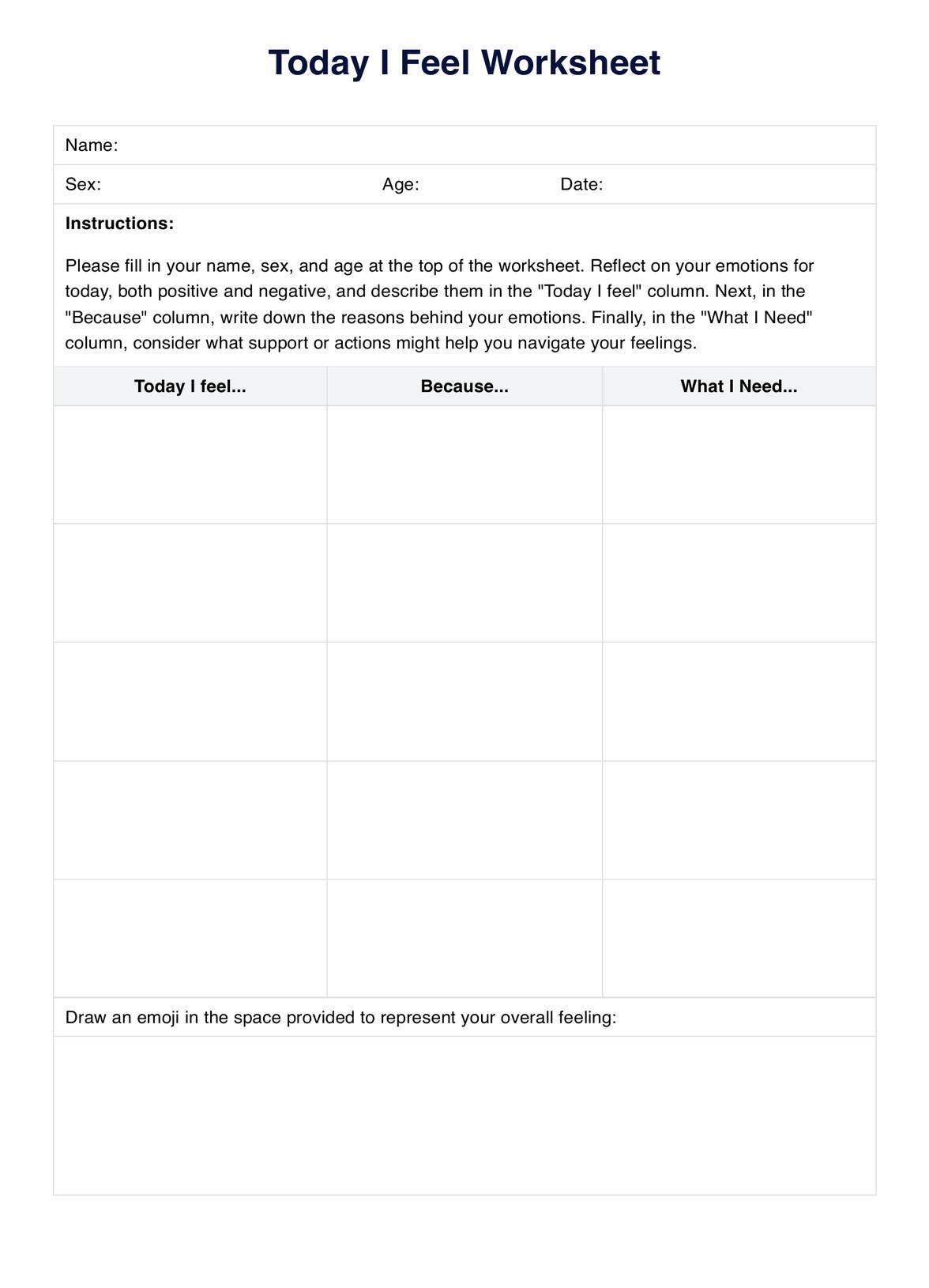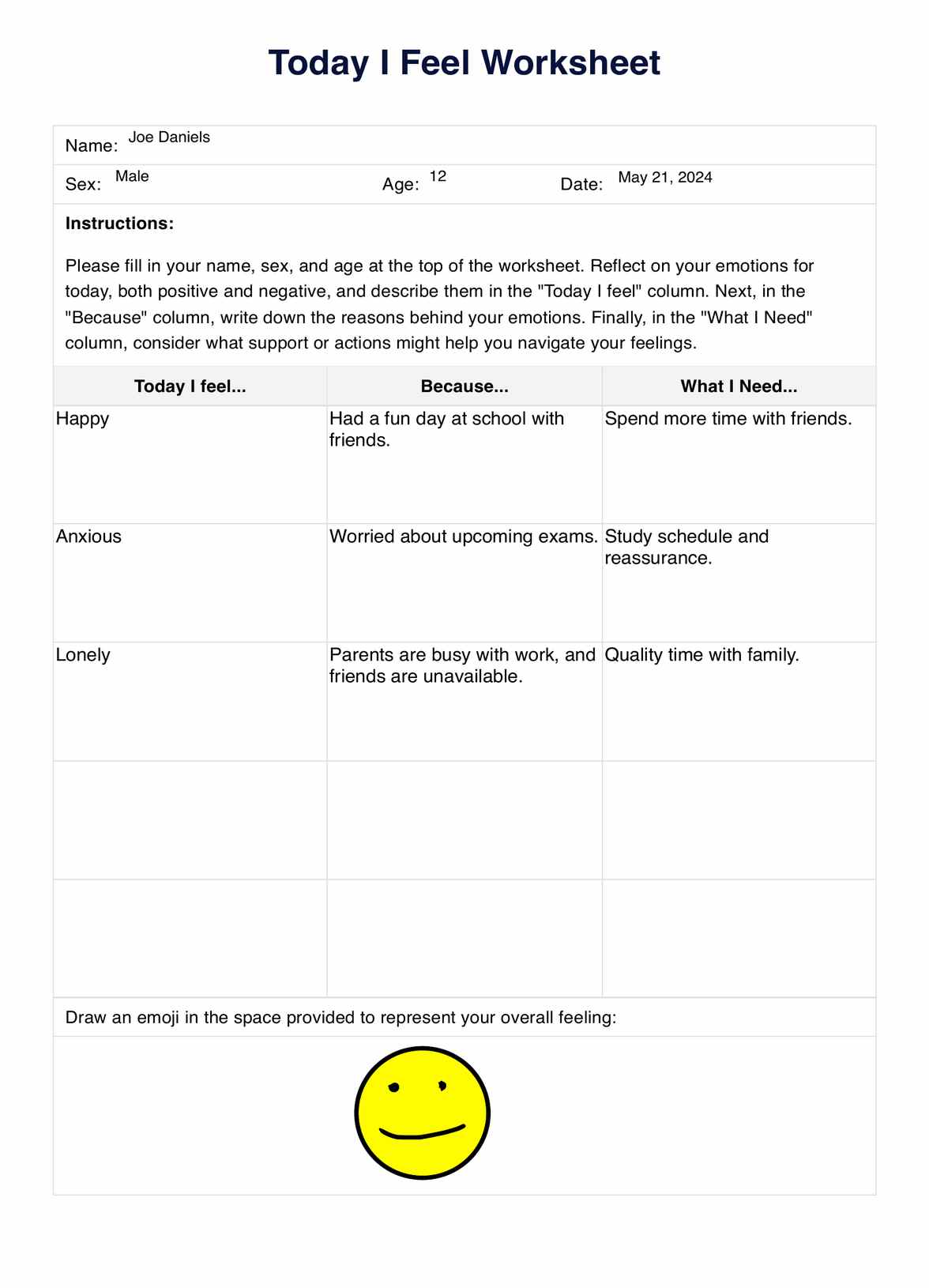Today I Feel Worksheet
Boost self-awareness in a fun way with the Today I Feel Worksheet. Download for free and explore the benefits.


What is social-emotional learning?
Before children grow into adults, they need to master essential skills that will help them succeed in life. Many adults face issues because they didn't learn critical emotional and social skills when they were young, carrying these deficits into adulthood. This can be challenging to deal with, often affecting their functioning and relationships.
Social-emotional learning (SEL) is the process of teaching children to acquire and apply five main skills: self-awareness, social awareness, responsible decision-making, self-management, and relationship skills (Souza, 2023).
SEL helps children grow into well-rounded adults capable of handling life's challenges effectively. The Committee for Children (2019) reported that 79% of employers state these skills are crucial for job success, and a 13% increase in academic achievement is linked to SEL programs. Emphasizing social-emotional learning in education prepares children for future success, both academically and in their careers. By facilitating emotional and social skills, programs help children thrive, benefiting not just individuals but society.
Today I Feel Worksheet Template
Today I Feel Worksheet Example
What is emotional regulation?
Also called emotion regulation, it is the ability to manage emotions, whether through conscious techniques like reinterpreting situations and changing reactions or unconsciously by naturally adjusting emotional responses. It generally improves with age (American Psychological Association, 2018).
During adolescence, emotion regulation skills can either improve significantly or deteriorate, potentially leading to psychopathological issues in some individuals. Parental socialization practices significantly influence this variability, affecting behavioral and neurobiological development (Silvers, 2021). This underscores the importance of caregiving in shaping emotional outcomes.
Why is this an important part of social-emotional learning?
Emotion regulation is vital to social-emotional learning because it helps students understand and manage their feelings effectively. Parents and teachers play a key role in this process by providing guidance and support as children discover how to express their emotions appropriately.
In the classroom, teaching these skills can address many behavioral concerns and create a more positive learning environment. When students learn to regulate their emotions, they are better equipped to handle challenges and build healthy relationships.
What is a Today I Feel Worksheet?
A Today I Feel worksheet is a tool for helping individuals identify and express their emotions. It typically includes spaces for individuals to write down how they're feeling today and why, fostering self-awareness and emotional literacy.
These worksheets can facilitate a conversation about emotions, allowing individuals to describe and talk about their feelings with others. They're often used in therapeutic settings or as a teaching tool to promote emotional intelligence and communication skills.
How to use our Today I Feel Worksheet
Understanding clients' daily emotions can help them become more attuned to their feelings. It provides a basis for developing strategies to enhance their social-emotional skills. Our Today I Feel Worksheet facilitates this process through these simple, guided steps:
Step 1: Download the worksheet
First, download the worksheet template. You may print it to provide a tangible copy for your client. Ensure the template includes spaces for the client's name, sex, and age and sections for their feelings, reasons, and needs.
Step 2: Fill out personal information
Ask your client to fill in their name, sex, and age at the top of the worksheet. This personal information helps to tailor the reflection to the individual.
Step 3: Reflect on emotions
Instruct the client to reflect on their different emotions for the day. They should consider both positive and negative feelings they've experienced. They will write down these feelings and emotions in the first column.
Step 4: Identify reasons
Next, have the client think about the reasons behind their emotions. In the second column, they should recognize what triggered these feelings. This helps them understand the context and possible patterns in their emotions.
Step 5: Determine needs
Guide the client in considering what they need to address their emotions. In the third column, they will jot down specific support or actions that might help them manage their feelings. Ask the client to draw an emoji representing their overall feeling to make the process engaging and visually expressive. This can be done in the designated space below the table.
Benefits of emotional regulation
Self-regulation greatly impacts one's life, shaping how we handle stress, interact with others, and achieve our goals. Here are some benefits of emotional regulation:
- Improved relationships: Managing emotions helps maintain healthier and more stable relationships. It enables better communication and conflict resolution.
- Better decision-making: Strong emotional regulation allows individuals to think more clearly and make more rational decisions rather than being driven by impulsive reactions.
- Increased resilience: Regulating emotions effectively allows people to cope constructively with challenges and setbacks. It helps enhance their ability to bounce back from adversity.
- Enhanced well-being: Managing emotions contributes to overall mental health. Effective emotion regulation strategies are positively linked to well-being, while deficits in emotion regulation correlate negatively, highlighting its importance for overall mental health and resilience (Kraiss et al., 2020).
These are just some of the advantages of developing emotional regulation. Remember that it is not an overnight success but a continuous process.
References
American Psychological Association. (2018, April 19). APA dictionary of psychology - emotion regulation. https://dictionary.apa.org/emotion-regulation
Committee for Children. (2019). What is social-emotional learning? https://www.cfchildren.org/what-is-social-emotional-learning/
Kraiss, J. T., ten Klooster, P. M., Moskowitz, J. T., & Bohlmeijer, E. T. (2020). The relationship between emotion regulation and well-being in patients with mental disorders: A meta-analysis. Comprehensive Psychiatry, 102(1), 152189. https://doi.org/10.1016/j.comppsych.2020.152189
Silvers, J. A. (2021). Adolescence as a pivotal period for emotion regulation development. Current Opinion in Psychology, 44(1). https://doi.org/10.1016/j.copsyc.2021.09.023
Souza, J. (2023, June 2). What is social and emotional learning? Child Mind Institute. https://childmind.org/article/what-is-social-and-emotional-learning/
Commonly asked questions
Emotional regulation is vital for managing stress, fostering healthy relationships, and achieving well-being.
Seeking help for emotional regulation is essential when difficulties in managing emotions start impacting daily functioning, relationships, or mental health.
The time to complete the worksheet varies depending on individual reflection and engagement, typically ranging from a few minutes to half an hour.





















-template.jpg)


















































































